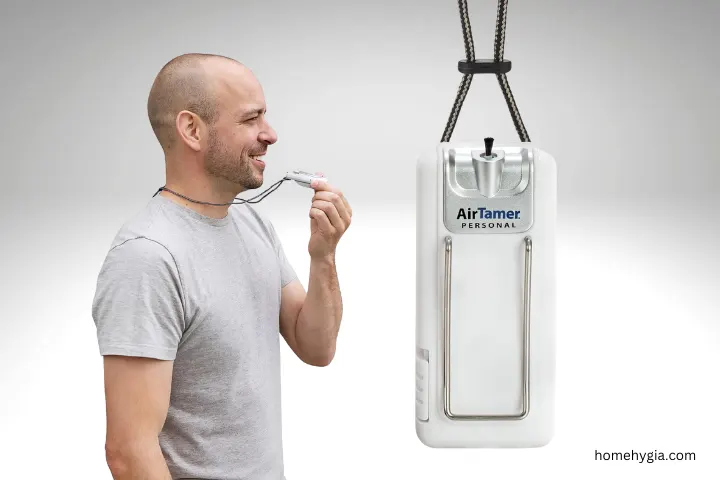Imagine walking through a bustling city street. The air is thick with pollutants, dust, and who knows what else. Now, picture yourself surrounded by a personal bubble of clean, fresh air. Sounds like something out of a sci-fi movie, right? Not anymore! Thanks to personal air purifiers, this futuristic idea is now a reality.
These portable devices are revolutionizing how we approach air quality, offering a compact solution for those seeking clean air in a variety of environments. Whether you’re commuting, working in an office, or relaxing at home, these purifiers are designed to combat allergens, bacteria, and even airborne viruses. But how exactly do they work? Let’s take a closer look.
How Personal Air Purifiers Work?
Personal air purifiers might be small, but they pack a punch when it comes to filtering the air around you. Here’s how these nifty gadgets work:
- Filtration Technologies
Most personal air purifiers rely on advanced filtration systems to clean the air. Let’s break down the key players:- HEPA Filters: Known for capturing tiny particles like dust, pollen, and pet dander. These filters are highly effective, removing up to 99.97% of particles as small as 0.3 microns.
- Activated Carbon Filters: Absorb odors, smoke, and harmful gases. Great for those sensitive to strong smells or chemicals.
- Ionizers: Emit negatively charged ions that bind with airborne particles, making them heavy enough to fall to the ground.
- UV-C Light Technology: Uses ultraviolet light to destroy bacteria, viruses, and mold spores.
Each of these technologies offers unique benefits, and many personal air purifiers combine multiple methods for maximum efficiency.
- Mechanisms of Action
- Air Intake: The purifier draws in surrounding air through vents.
- Filtration: Air passes through one or more filtration stages, depending on the model.
- Clean Air Release: Filtered air is released back into your personal space, creating a cleaner bubble of air around you.
This continuous process ensures that the air you breathe is significantly cleaner than the air around you.
Benefits of Using Personal Air Purifiers
You might be wondering: why invest in a personal air purifier? The benefits go far beyond clean air.
- Health Benefits
- Reduced Allergens: These purifiers are a godsend for allergy sufferers, effectively reducing pollen, dust, and pet dander in the air.
- Asthma Relief: Cleaner air means fewer irritants that can trigger asthma attacks.
- Protection from Airborne Viruses: Certain models equipped with UV-C technology can help neutralize airborne pathogens, adding an extra layer of protection in crowded spaces.
- Convenience and Portability
- Compact and lightweight, personal air purifiers are perfect for people on the go.
- Many models are wearable, like necklaces, or small enough to fit in your bag or car.
- Energy Efficiency
- Compared to larger air purifiers, these devices consume far less energy, making them both cost-effective and eco-friendly.
- A Practical Solution for Various Settings
- Use them at work to combat stuffy office air.
- Take them on public transport to avoid exposure to pollutants.
- Keep one by your bedside for a restful, allergen-free sleep.
Why They’re Becoming a Must-Have?
The rise in pollution levels and the increasing awareness of airborne diseases have fueled the popularity of personal air purifiers. According to a 2023 report by MarketWatch, the personal air purifier market is projected to grow by 15% annually, highlighting their growing importance.
Think about it: With these compact devices, you can take control of the air you breathe, wherever you go. It’s like carrying your own pocket-sized sanctuary of fresh air.
Types of Personal Air Purifiers
Personal air purifiers come in a variety of forms, each catering to different needs and lifestyles. Here’s a look at the most popular types:
- Wearable Air Purifiers
- Designed as necklaces or clip-ons, wearable purifiers create a personal bubble of clean air.
- They often use ionization technology to reduce airborne particles in your immediate surroundings.
- Best For: Commuters, travelers, or anyone frequently exposed to crowded spaces.
- Desktop Air Purifiers
- Compact units ideal for office desks, nightstands, or workstations.
- Typically equipped with HEPA and activated carbon filters to remove allergens and odors.
- Best For: Office workers or individuals seeking cleaner air in small, stationary spaces.
- Car Air Purifiers
- Plug into your vehicle’s cigarette lighter or USB port.
- Great for filtering out exhaust fumes and allergens that enter through the car’s ventilation system.
- Best For: Road warriors or families with kids and pets on the go.
- Travel-Friendly Portable Purifiers
- Battery-operated or rechargeable units that fit easily into a backpack or suitcase.
- Some include multiple filtration stages for higher air quality.
- Best For: Frequent flyers or vacationers concerned about air quality during trips.
- USB-Powered Mini Purifiers
- Ultra-small purifiers powered by a USB connection.
- Lightweight and convenient for personal spaces.
- Best For: Students, digital nomads, or remote workers.
Key Features to Consider
Not all personal air purifiers are created equal. Here are the key features to look for when choosing the right one:
- Filter Types
- HEPA Filters: Essential for removing fine particles like dust, pollen, and pet dander.
- Activated Carbon Filters: Excellent for tackling odors, smoke, and VOCs (volatile organic compounds).
- UV-C Technology: Provides an extra layer of protection by neutralizing bacteria and viruses.
- Battery Life and Power Options
- Portable models should offer long battery life for convenience.
- Consider models with USB-charging capability for travel-friendly use.
- Noise Levels
- Noise-sensitive users should opt for purifiers with quiet operation (below 40 decibels).
- Many manufacturers list noise levels in their product descriptions.
- Coverage Area
- Ensure the purifier’s coverage matches your needs—smaller purifiers work well for personal spaces but may struggle in larger rooms.
- Additional Functionalities
- Some purifiers include aromatherapy options or dual functions like humidification.
- While these extras are nice, focus on core air purification features to maximize value.

Top Personal Air Purifiers in 2025
To help you make an informed choice, here’s a comparative analysis of leading personal air purifiers:
| Model | Price Range | Key Features | Best For |
| AirTamer A310 | $100–$150 | Wearable, ionizer, 150-hour battery life | Frequent travelers |
| Dyson Pure Cool Me | $300–$400 | HEPA filter, customizable airflow | Small home spaces, bedside use |
| Molekule Air Mini+ | $400–$500 | PECO filtration, app-enabled controls | Tech-savvy users, allergy sufferers |
| Wynd Essential | $200–$250 | Compact, medical-grade filter | Office desks, small rooms |
| IQAir Atem Desk | $400–$500 | HyperHEPA filtration, ultra-quiet | Professionals needing clean desk air |
Why Features Matter
Selecting a personal air purifier that aligns with your needs is essential. For example:
- If you travel often, prioritize portability and battery life.
- For allergy relief, go for models with advanced HEPA filters.
- Concerned about odors? Look for a purifier with activated carbon technology.
Personal air purifiers are not one-size-fits-all, so taking time to evaluate features ensures you’ll make a purchase that truly enhances your air quality and lifestyle.
Considerations Before Purchasing
Before buying a personal air purifier, take the following into account to ensure it fits your needs:
- Assessing Personal Needs
- Do you need a purifier for allergies, odor control, or general air quality improvement?
- Is portability a priority, or do you need a stationary unit for a specific space?
- Budget Constraints
- Set a budget that includes ongoing costs, such as filter replacements and electricity.
- Affordable options exist, but consider spending a bit more for features like HEPA filters and energy efficiency.
- Certifications and Warranties
- Look for certifications like CARB compliance or Energy Star ratings to ensure quality and safety.
- A good warranty (at least 1 year) can provide peace of mind.
How to Use Personal Air Purifiers Effectively?
Using a personal air purifier is simple, but a few tips can help you maximize its efficiency:
- Optimal Placement
- Keep the purifier as close to you as possible, especially for wearable or desktop models.
- For stationary use, place it in an unobstructed location for maximum airflow.
- Duration and Frequency
- Use the purifier continuously in high-pollution environments, such as during commutes or in busy offices.
- At home, use it in spaces where you spend the most time, like your bedroom or workstation.
- Safety Precautions
- Avoid ionizers if you’re sensitive to ozone emissions, as some models produce trace amounts.
- Follow manufacturer guidelines for operation, particularly around children or pets.
Pro Tip: Pair your purifier with natural ventilation whenever possible for optimal air quality.
Maintenance and Care
Regular maintenance is crucial for keeping your personal air purifier effective and long-lasting:
- Cleaning Procedures
- Clean the exterior regularly with a damp cloth to prevent dust buildup.
- For models with washable filters, rinse them gently every 1–2 weeks.
- Filter Replacement
- Replace HEPA or activated carbon filters as per the manufacturer’s recommendations (usually every 6–12 months).
- Monitor for signs like reduced airflow or unusual odors, which indicate the need for a new filter.
- Troubleshooting Common Issues
- Low Airflow: Check for clogged filters and clean or replace them.
- Unusual Noise: Inspect the fan for obstructions or debris.
- Power Problems: Verify the battery charge or ensure the USB cable is working correctly.
FAQs
1. Are personal air purifiers effective?
Yes, especially in small, enclosed spaces. Models with HEPA filters can capture up to 99.97% of airborne particles, including dust, allergens, and some bacteria.
2. How long do personal air purifiers last?
With proper maintenance, most models last between 3–5 years. Battery-operated purifiers may require battery replacements over time.
3. Can I use a personal air purifier outdoors?
Some wearable models are designed for outdoor use, but they’re most effective in low to moderate pollution environments.
4. Are ionizers safe to use?
Ionizers are generally safe, but they can produce small amounts of ozone, which may be a concern for those with respiratory issues. Look for models labeled as ozone-free.
5. How much does it cost to maintain a personal air purifier?
Maintenance costs range from $20–$100 annually, depending on filter type and frequency of replacement.
Final Words
In today’s world, where air pollution and allergens are on the rise, personal air purifiers have emerged as a practical solution for maintaining better air quality wherever you go. From wearable devices to compact desk models, these purifiers offer flexibility and efficiency tailored to your lifestyle.
By understanding the types, key features, and maintenance needs, you can select a purifier that meets your specific requirements—whether it’s for reducing allergens, combating odors, or ensuring clean air during travel.
Investing in the right purifier isn’t just about cleaner air; it’s about creating a healthier environment for yourself and your loved ones. So, take the first step toward breathing easier today. Clean air is just a filter away!
